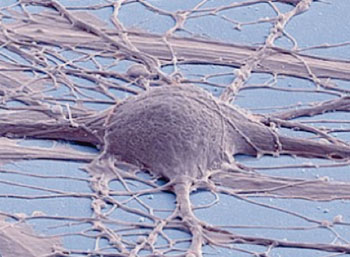Induced Stem Cells Show Genetic Abnormalities Not Found in Embryonic Stem Cells
By LabMedica International staff writers
Posted on 16 Jul 2014
All stem cells are not created equal: genomic evaluation revealed that the genome of stem cells generated from adult cells (induced pluripotent stem cells or iPS cells) differed considerably from that of "gold standard" human embryonic stem cells (ES cells).Posted on 16 Jul 2014
Human pluripotent stem cells hold potential for regenerative medicine, but available cell types have significant limitations. Although ES cells from in vitro fertilized embryos (IVF ES cells) represent the "gold standard," they are genetically distinct from likely transplant recipients, and their use is compromised by ethical and logistical considerations. While autologous iPS cells are freely obtainable, they are prone to epigenetic and transcriptional aberrations.

Image: Scanning electron micrograph of cultured human neuron from induced pluripotent stem cell (Photo courtesy of the University of California, San Diego).
A team of researchers from the University of California, San Diego (USA), Oregon Health & Science University (Portland, USA) and the Salk Institute for Biological Studies (La Jolla, CA, USA) cooperated to perform a study to determine whether abnormalities found in iPS cells were intrinsic to somatic cell reprogramming or secondary to the reprogramming method. To this end, they prepared genetically matched sets of human IVF ES cells (four lines), iPS cells (seven lines), and two lines of nuclear transfer ES cells (NT ES cells) derived by somatic cell nuclear transfer (SCNT). The 13 cell lines were examined by genome-wide analyses.
Results published in the July 2, 2014, online edition of the journal Nature revealed critical differences in the genomes of stem cells created with the three methods. Specifically, DNA methylation and gene expression patterns in nuclear transfer ES cells more closely resembled those of ES cells than did iPS cells, which revealed alterations apparently caused by the reprogramming process.
“The nuclear transfer ES cells are much more similar to real ES cells than the iPS cells,” said co-senior author Dr. Louise Laurent, assistant professor of reproductive medicine at the University of California, San Diego. “They are more completely reprogrammed and have fewer alterations in gene expression and DNA methylation levels that are attributable to the reprogramming process itself. Our results have shown that widely used iPS cell reprogramming methods make cells that are similar to standard ES cells in broad strokes, but there are important differences when you look really closely. By using the egg cell to do the job, we can get much closer to the real thing. However, not only is nuclear transfer technically difficult, but federal funds cannot be used in experiments involving this procedure. If we can figure out what factors in the egg drive the reprogramming process, maybe we can design a better iPS cell reprogramming method.”
Related Links:
University of California, San Diego
Oregon Health & Science University
Salk Institute for Biological Studies













